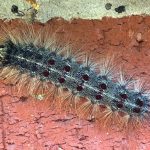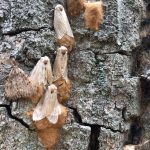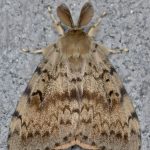Spongy Moth
Identification:
Spongy moths (formerly known as gypsy moths) as larvae, caterpillars can grow to two inches long and have five pairs of blue spots and six pairs of rusty red spots along their backs. Female moths are one to two inches long and do not fly. They have cream-colored wings with dark-brown zigzag markings. Males are smaller than females and are brownish-gray. They have similar markings on their wings and have feathered antennae. Eggs are laid in a fuzzy pale-yellow colored mass in late summer to early fall. Egg masses are laid on virtually any surface that offers protection, from bark crevices and the underside of branches to mailboxes and campers. Pupae are reddish-brown and leathery. Female pupae are larger than males. Adult moths emerge in mid-summer.
Control:
Management of the spongy moth varies over the course of the year to target the life stages present. While some management approaches are appropriate for individual yard trees, other approaches are reserved for trained arborists and/or governmental program.
Destroy egg masses by spraying them with a horticultural oil labeled for spongy moth (Lymantria dispar) egg masses or by scraping them off and killing them. Spray the oil onto the egg mass until it is soaked. If you scrape off egg masses, be very careful not to harm the bark of the tree, as you could do more damage than good. Use a knife or paint scraper to gently scrape all the eggs into a container containing soapy water. Close the container and leave them there for 2 days before disposing of them in the trash. Do NOT scrape egg masses onto the ground or try to crush them as many may survive to hatch in the spring. Any parts of the egg mass you are unable to scrape off the tree can also hold surviving eggs.
Just after spongy moth (Lymantria dispar) eggs have hatched and caterpillars are small, barrier bands can prevent them from climbing back into trees after ballooning or when they have fallen. Barrier bands can be made using duct tape or other nonporous material that can be wrapped around a tree trunk and coated with a commercially available sticky material such as TangleFoot® or Vaseline®. NEVER put sticky material directly on the tree trunk. On thin-barked trees, tie butcher paper or paper bags around the trunk before using the duct tape. The sticky material may need to be re-applied periodically due to rain and other environmental conditions as well as when the bands are covered with caterpillars.



